I always feel bad pushing pre-baked bread dough down once it rises, deflating it of what it was, for fear that it won’t rise again as high. But it does. I guess that’s the thing about resilience.
In Paris, especially when I had almost no money, or when I didn’t want to bother with cooking in the heavy heat of deep summer, over a hot-something that was proxy for a stove — in my case — a single plug-in hot plate, I ate bread.
It was very cheap and I always found la tradition tastier than the plain baguettes. They had thick, crusty golden gashes across their tops and were so simple and delicious with (as cliché will have it) …creamy cheese, most often St-Marcellin, charcuterie and a glass of red wine.
But even before reaching my plate, I would pinch off a piece, pas trop cuite, as soon as I descended into the cobble-stoned street and steam would climb up to my face in a wispy stream. It was not a bad life.
But, as good as bread tastes, baking it by hand is almost like taking photographs with an old-fashioned film camera… and then developing them in the dark by yourself. The gratification of a pretty photograph or a good-looking loaf, is far from instant and you can barely see, so you’ve got to go by feel: Too dry? More flour? How elastic should it be, exactly? It’s rustic and tactile, and should maybe, be left to the professionals… or at least to our grandmothers, who were — like crafty, homemade experts — grand at it.
Don’t get me wrong, I love the smell of bread baking as much as anyone who keeps the windows shut just to tickle their nostrils with the smell of flour and yeast… but it’s an indulgence that taxes us for time, isn’t it? We’ve got to master patience.
And even for the more experienced of bread bakers (of whom I do not count myself among), there’s often that tinge of doubt, that persistent pampering of a thing that has an affinity for being all too finicky all too often. And while the bread rises and re-rises, the maker of that bread is more than entitled to ask herself, “Will it be worth it?”
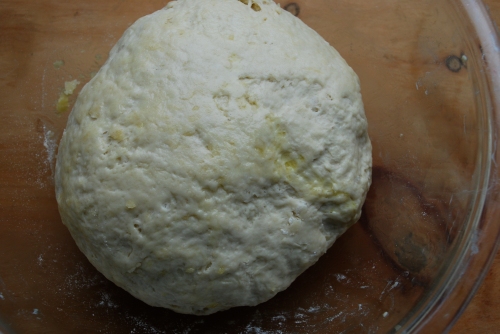
I think it is — I think this is. For all my quips about impatience in bread (and in life), this focaccia is worth slowing down for. It’s strewn with sweet smelling rosemary and slivers of salty black olive and it should absolutely be shared with friends or with family for no occasion but the beauty of the moment you’re in — or whenever you’ve got a hankering for a crispy hunk of bread that’s got pitted black rubble of olives sprinkled across it in a fragrant fling of flavor.
It’s great for toasted sandwiches with paper-thin slices of salami or smeared with ricotta and honey and chopped chives or pesto. And by day three, (if you’re a better-balanced eater than I tend to be, if you are restrained and your leftovers make it this far), you can bake any final crusts (because fresh bread does dry out more quickly), into easy, DIY olive-rosemary breadcrumbs, which go great with almost any salad you’re thinking about for lunch, or as a welcomed texture clash for an otherwise one-tone meal.
Adapted from Bon Appétit (May 1995) via Epicurious.com.
- 4 1/2 cups all-purpose flour
- 2 cups warm water (105-115°F)
- 2 teaspoons dry yeast
- 2 teaspoons salt
- 3 tablespoons olive oil, plus more for baking sheet
- handful of black olives, pitted and chopped
- 1 tablespoon fresh rosemary, chopped
- course salt, for sprinkling
Preheat oven to 450°F and lightly grease a 15 x 10″ baking sheet.
In a large bowl, gently stir dry yeast into warm water and let sit until dissolved, about ten minutes.
Stir in 4 cups of flour, 1 tablespoon olive oil, and salt, until a rough ball begins to form. Sprinkle flour across a clean, flat surface. Lift dough out of the bowl and begin to knead it over the floured area with the heels of your palms. Dough will be sticky at first, but as it is kneaded, will become smoother and elastic. Knead about ten minutes, adding additional flour (up to about 1/2 cup more) if dough remains rough and sticky. Form dough into a large smooth ball.
Pour 2 tablespoons olive oil into a large bowl and roll dough in oil to coat it. Cover bowl with plastic wrap, and allow dough until it has doubled in size, about 1 1/2 hours.
Punch dough down and allow dough to rise again, covered, about 45 minutes or until it has doubled in size.
After dough has doubled, punch down again, pressing and patting it onto the prepared baking sheet, leaving about 1″ on each end of the length of the baking sheet. Allow dough to rest in pan about ten minutes, then dimple surface of dough with finger tips and drizzle with olive oil, sprinkling with course salt, fresh rosemary and chopped olives.
Allow dough to rise on baking sheet for another 25 minutes and then bake in oven until golden brown, about 15-20 minutes. Serve warm.
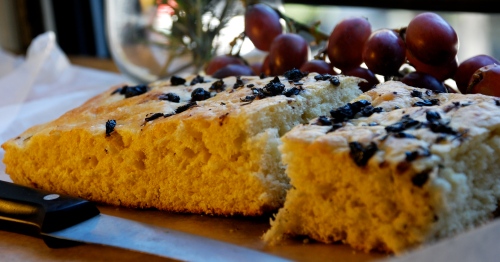
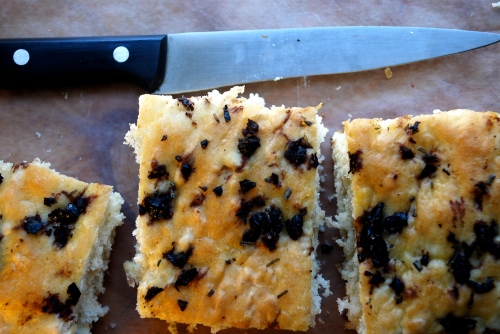
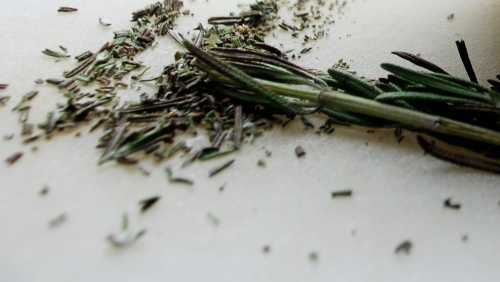
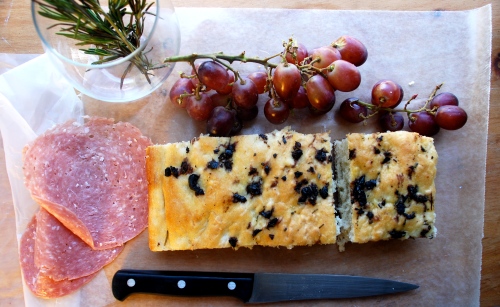
Pingback: Panini alle Olive (Olive and Rosemary bread rolls, made in a food processor) | Silvia's Cucina
Hi there! I have nominated you for the Sunshine Award! If you’re interested, please click
the below link and read the rules.
http://traceinthekitchen.com/2013/05/16/sunshine-award/
@traceinthekitchen: Thank you so much. It means a lot and I’m so inspired by things I’ve read from you. Especially that dream-of-a-caramelized banana pudding. And that granola. : ) Onward!!